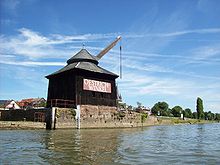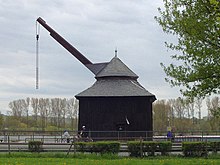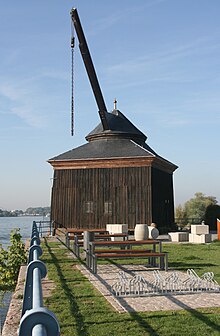Oestrich crane
The Oestricher crane , also known as the old Rhine crane or wine loading crane , is a baroque harbor crane in Oestrich (Rheingau) in Hesse . The wooden crane was mainly used to load wine barrels , but also other goods such as tree trunks onto ships on the Rhine .
history
Building and operating a crane was an archiepiscopal privilege until the 19th century . It ensured that only a few cities in the Rheingau and other German areas had the right to operate such a loading device, so all places with stacking rights such as Cologne , Trier , Würzburg , Andernach , Bingen am Rhein , Stade , Hamburg etc. in the Rheingau In the 15th century, only Eltville , Rüdesheim and Lorch were granted this privilege. The Oestricher crane is located directly on the Rhine at Rhine kilometer 518.1, near federal highway 42 .
The Archbishop of Mainz and Elector Johann Friedrich Karl von Ostein , whose coat of arms is carved into the sandstone plinth on the Rhine side, approved the erection of a land crane in Oestrich, the last municipality in the Rheingau, after the land clerk Heyntzmann of the archbishop's court chamber in Mainz reported the poor condition on April 14, 1744 of the old floating crane there from the 16th century. He recommended the construction of a land-based crane on the banks of the Rhine, as a land crane is safer (no rocking movements), largely independent of the water level and more durable than a new floating crane. All cranes in the Rheingau and elsewhere, such as in Trier and Andernach, were initially made of wood, which were mostly very susceptible to repair due to constant exposure to water and ice in winter. Crane construction began at the end of April, parallel to the performance of the necessary quay . The construction of the quay wall and its foundations , which are more than 1.50 m deep , were made from the remaining stones from the new Mainz palace , while the remaining blocks were brought in elsewhere. The masonry work is in charge of master mason Schneller. The crane house (8 m side length) was built by the master joiner Josef Möhler from Oestrich from solid oak logs ( half-timbered construction ) that were covered with wooden boards. The master roofer Weiß covered the crane boom (oak wood) with lead plates and sealed it with pitch . On August 4, 1745, after a construction period of 16 months, the crane was dismantled and put into operation; it only stopped working in 1926 after 181 years. Despite the enormous sum of 6,000 guilders , the construction was justified by the increased economic importance and the safer, more pleasant and faster work. It was mainly used for loading wine barrels (1780: 420 1,200 liter barrels) and tree trunks, but other goods were also loaded with it.
functionality
The type of the Oestricher crane is a wooden, land-based tower crane. The designation land crane (s) or house crane (s) differentiates it from the floating crane or crane ship. The board-lined, slightly tapering crane house with a total height of 12 meters and a half-timbered construction stands on a sandstone block base of 7.90 × 8.00 meters. Two windows each up and down the Rhine are let into the walls, the entrance is on the land side. The slate-covered roof is in the form of a tent stump over a profiled wooden cornice, above which the conical roof rotates with the protruding arm, consisting of the 9 meter long upper beam and 8 meter long lower beam, protected by lead plates. The conical roof with dome and point is firmly connected to the upper end of the central, vertical crane column ("Kaiserbaum"). The horizontal rotating beam is firmly mounted on it below the treadle axle, by means of which two to four crane workers turn the boom or crane beak with the load and the entire drive. The crane chain with a loose roller in the hook runs, attached at the front end of the jib, which is approx. 15 meters above the ground, over the fixed roller in the protected jib tip, via another roller at the end of the jib, into the inside of the crane to the chain winch , mounted on the horizontal drive axis of the two Running or pedal bikes , attached to the Kaiserbaum. The winch was driven by crane servants (wheel runners, winch servants), usually two per wheel. According to tradition, prisoners were used here, otherwise since the Middle Ages and also later on construction sites and in cranes, there were well-paid, professional treadmills on site who were organized in the guild of loaders . With particularly heavy loads (maximum 2.5 tons ), additional crane workers reached into the spokes of the drive wheels. There was no locking device for the wheels when the load was attached (increased risk of accidents). A crane foreman managed the crane and assessed the loading according to a precise list of charges, kept by a crane clerk. He commanded the workers and also paid the piecework wages of the crane workers - provided there were no prisoners - for their often dangerous work. Some stone cranes, like the no longer existing Düsseldorf Rhine crane, had an extension especially for the crane master. In principle, the crane is still fully functional.
Other cranes
The landmark of the city of Oestrich-Winkel is under monument protection and is today the last historical loading crane for wine and other goods on the right bank of the Rhine and next to the Rhine crane in Bingen and the old crane (stone crane , formerly called house or Rhine crane ) in Andernach the last of its kind Art on the Rhine.
More Tretkräne are in: (Stade Age salt Crane ), Lüneburg ( Old Crane ), Trier ( age Krahnen and customs Crane ), Saarbrücken ( Saar Crane ), Würzburg ( Alter Kranen ) and Marktbreit ( Alter Kranen ). In Rostock , too, a replica of a round wooden harbor crane from the 18th century has stood on the Warnowufer since 1996.
See also
literature
- Hagen Gebauer: 250 years of Oestricher Kran . In: Heimatjahrbuch des Rheingau-Taunus-Kreis 46 (1995), pp. 165–167.
- Rudolf Rosensprung: The Oestrich crane . In: Heimatforschung, Heimatliebe (1983), pp. 102-105.
Web links
Coordinates: 50 ° 0 ′ 10.5 ″ N , 8 ° 1 ′ 48.5 ″ E


